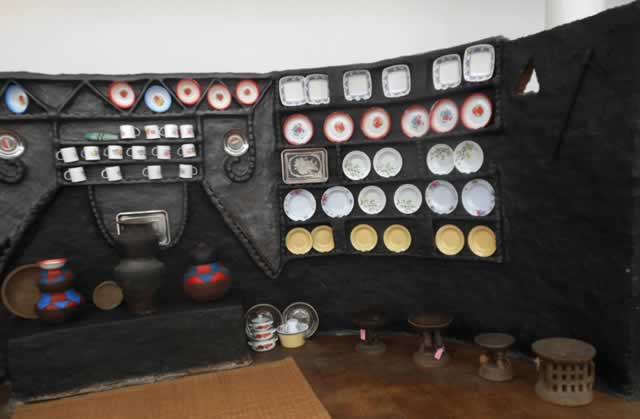Inside women’s traditional space

Stephen Garan’anga Visual Art
The woman decorated structure in free hand smeared black fine clay earth exposes three particular sets of shelves’ designs at the far back right in the middle third of what would be a complete round hut from the doorway.
The cylindrical and cone grass thatched hut is still the family magical space manned by women in rural life of most countries in Africa south of the Sahara.
It is the space of headaches for the women during hard times of inadequate food where they wonder what to prepare to feed the family as the sun rises through the cool morning temperatures and when it disappears to rest.
It is a space which families converge to ruminate on the day’s hard work, find solutions for tomorrow or plot somebody’s downfall whilst they refill their depleted energy reserves.
It is the guest house, a space for the renowned women’s gossips, a space for traditional rituals and funerals. It is indeed a space for many functions. Whilst all that bounds families and relations together, special attention is paid to how the space looks by somebody and it is a major concern for the women in the rural life setting.
They immensely worry about how the visitors will perceive of the space and presume on the well-being of the family. There it becomes their critical space of creativity, not only for the delicious cooking, but bringing out to the surface some things they never went to school for the will to continually transform that special space into a pleasant home.
They construct immaculate structures on the inner cylindrical walls and at times extend outward and decorate their kitchen wares to be displayed in a way how they should be viewed. It is a natural talent of interior design at its highest level.
Even with the daily menacing smoke tainting their creativity, they give it time to go out there in search of special clean earth of colour which they will treat to resurface the whole interior to enhance their designs.
They design like no other on earth their clay pots of which are essentially the natural objects of every traditional kitchen especially in Zimbabwe. These designs have a history, a history which was never mentioned by the Portuguese when the indigenous Africans first met with the Europeans several centuries ago.
In Zimbabwe, tens of thousands of years ago were San people who were hunters and gatherers, living in caves or under cliffs. They migrated extensively in family groups throughout the Kalahari Desert and the surrounding areas living thousands of rock paintings depicting animals and hunting scenes.
These rock paintings express artistic creativity throughout the centuries and are part of the roots of Zimbabwean art. Another traditional art form was found in the often finely decorated clay pots of the Bantu who migrated from the north several hundreds of years, establishing a society founded mostly in agriculture.
They had knowledge of working iron and thus decisive social changes took place over the centuries which, with the discovery of, work on and trade with gold- first mentioned in the tenth century — led to the prospering of the by now well organised dynasties of the Shona people, culminating in the Empire of Great Zimbabwe.
Artistic remnants of carved stone birds and other figures dating back to the 13th century found at the ancient rectangular granite stone walled Great Zimbabwe as well as fragments of designed clap pots. With time the intermixing of various people formed new cultural traditions that came with their own various art forms.
This essential piece of history is what the National Gallery of Zimbabwe in Harare is currently basing to expose to general populace and beyond the Zimbabwean and Africa’s rich tradition of design in a show themed ‘Design Zimbabwe: The Traditional Kitchen’.
A cut-off semi-circular piece of the traditional round hut kitchen brick wall stands proudly unthatched on the floors of the upper East Gallery, well designed and decorated on the curved interior with masterful inherited indigenous talent apart from the modern Chinese eating metal plates and cups also furnishing the shelves.
The woman decorated structure in free hand smeared black fine clay earth exposes three particular sets of shelves’ designs at the far back right in the middle third of what would be a complete round hut from the doorway.
The intricate middle shelve boasts triangular structures on the uppermost section in which colourful metal eating plates are secured with a double empty compartment of which its contents have been retrieved for use. Beneath the triangular structures right on the immediate middle are triple slim rectangular cup shelves on top of each other proceeding downwards again with some missing contents in use.
About 30 centimetres or so on either side of the cup shelves attached on the final line of the upper plates’ shelve as if hanging downward are letter J-like shaped structures with the left one turning away, both with securing identical round sparkling silver plates on their curved tips.
Back in the middle further down below and attached to the baseline of the cup shelves the thicker side of a semi oval structure emerges down to about three quarters of a meter from the floor, securing yet another silver sparkling rectangular food tray.
A few centimetres on both sides of the semi oval tray shelve emerging from the same final ends of the cup shelves are diverging structural lines slanting toward the vertical sides of other sets of rectangular shelves full of their contents connecting to the middle one.
The irregular shaped spaces formed in-between the upper sides of the slanting lines are magnificent as enhanced by the rippled designs underlying all the structural constructions.
The slanting lines too form a three sided part of a hexagon or a heptagon encompassing the semi oval structure of the tray and directly under it rising about half a meter from the floor is a short “rukuva” (a seeming round hut curved rectangular prism bench) where other kitchen essentials like medium to small sized clay pots (pfuko ne makate), pots, pans and various food containers are stored.
On the mini rukuva are three sets two designed clay pots on top of each other placed a few centimetres apart facing upwards. The designed middle pair in its burnt raw earth sits on a small vas of similar making with an open traditional wooden plate at the top partially obstructing the semi oval shelve of the tray.
The first pair on the left covered by an open metal plate at the top have similar designs in sky-blue and permanent red rectangular shapes on the rim connecting to alternating triangular designs below of same colours decorating the upper third of the spherical body.
The bottom parts are left untouched and partially behind on the extreme left is a much larger circular traditional wooden plate leaning against the wall. In-between the first and the second clay-pot sets is another smaller wooden plate resting on both the wall and the middle set.
The extreme right set has the larger bottom pot in similar designs as those of the first set and the open top pot is in the same burnt raw earth as the middle set.
Two fairly big silver dishes are resting against the wall on the floor behind a set of three white floral red metal pots before a big yellow basin covered with a plate on top with an upside down cup on the immediate right end of rukuva.
A short distance further to the right up to the end of the structure along the wall are four shot ancient traditional wooden stools of various carved designs belonging to the National Gallery’s permanent collection placed at similar distances apart.
Before rukuva inward from the entry is ‘rukukwe’ (a traditional sitting or sleeping reed woven mat) stretched on the floor. At the beginning of the structure to the left is ‘guyo nehuyo’ (carefully selected and shaped fragments of hard rock used by women to hand grind various grain for mealie meal, ground nuts for peanut butter, round nuts, cowpeas to mention a few).
Guyo is the bigger and heavier of the two on which the substance to be ground is placed and huyo is the much smaller held by both hands when grinding.
The guyo on the setting tells a tale of tonnes of food it has seen off by the smooth deep depression that has developed on the middle to complete the cut-off piece of the ancient traditional kitchen setting.
Other pieces of the show include various large photographic images of modern rural Mhondoro traditional kitchens’ interior designs and decorations. Present too are traditional, but modern basketry collections of design and colour and other traditional kitchen objects belonging the National Gallery.
There are also works by sculptors Gideon Gomo and Charles Sakonda, fashion designers Sabina Mutsvati and Ska Sebata, ceramist Marjorie Wallace, Nyari Kudhani Gurupira, Joseph Munemo, Adrien des Vos, Sebastin Herkner, Hayhill weavers and Bulawayo Home Industries.
The exhibition was co-curated by Mai Doreen Sibanda, the executive director of the National Gallery of Zimbabwe and Professor Saki Mafundikwa, the founder and director of Zimbabwe Institute of Vigital Arts (ZIVA) and is the first of an intended series of shows to be put up to expose to the world Zimbabwe and Africa’s designs and of history.










Comments